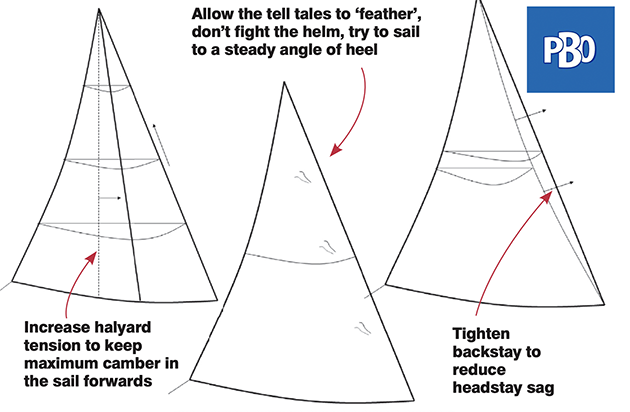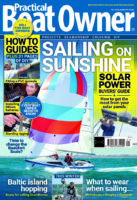PBO reader Jenny Spear wants advice on how to improve the performance of her boat's headsail. Ian Brown has this brief guide to headsail trim
Although many cruising sailors won’t be as inclined to tweak sail controls as readily as racing sailors, the fact remains that an understanding of what the basic controls are, what they do and being prepared to change things once in a while can have a significant bearing on sail shape and therefore the manageability of both the sail and the boat.
The four primary controls are halyard tension, sheet lead position, sheet tension and backstay tension.
Increasing halyard tension pulls the position of maximum draft in the sail forwards. This, in turn, flattens the aft sections of the sail, thus reducing heel and backwinding.
More halyard tension is needed as the breeze increases, although care should be taken not to over-tension the luff, as indicated by a ‘gutter’ that runs parallel with the luff.

Headsail trim techniques
The sheet lead position should be set so that it roughly bisects the clew, applying equal tension to the leech and foot as the sail is sheeted.
If you imagine a line extending up through the sail as a continuation of the sheet, it should meet the luff of the sail in the middle.
As the breeze increases and the sail is sheeted harder, the genoa car will need to come aft slightly.
Backstay tension directly affects the amount of headstay sag (to a greater or lesser degree, depending on the rig characteristics of a particular boat).
More sag adds depth, creating a more powerful sail. Once again, as the breeze increases, you should pull the backstay on harder to help prevent the headsail from becoming excessively deep.
If your boat is becoming a bit of a handful, don’t be afraid to try these little adjustments.
Trysail trimming: a guide for sailors
Ben Meakins explains how to set and deploy trysails to improve boat control in high-wind conditions
Sail trim: Sailing downwind without a spinnaker
Sailing efficiently when the wind comes astern doesn’t mean you have to fly a spinnaker or cruising chute. David Harding…
Simple tweaks to sail faster and safer
The ability to sail faster and more efficiently can also be safer and more satisfying. Peter K Poland explains...
Want to read more practical articles like How important is headsail trim?

A subscription to Practical Boat Owner magazine costs around 40% less than the cover price.
Print and digital editions are available through Magazines Direct – where you can also find the latest deals.
PBO is packed with information to help you get the most from boat ownership – whether sail or power.
-
-
-
- Take your DIY skills to the next level with trusted advice on boat maintenance and repairs
- Impartial, in-depth gear reviews
- Practical cruising tips for making the most of your time afloat
-
-
Follow us on Facebook, Instagram, TikTok and Twitter







